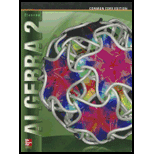
Concept explainers
(a)
To find: the probability of getting a club or diamond.
(a)
Answer to Problem 3E
The probability of club or diamond is
Explanation of Solution
Given:
Total number of posssible outcomes of cards is
Concept used:
The number of ways of arranging
The probability formula is used to compute the probability of an event to occur as:
Calculation:
Consider the standard deck of cards . the total number of posssible outcomes of cards is
This situation is mutually exclusive because a card cannot be both a club and a diamond.
The probability of club or diamond is as follows:
Here,
Total outcomes of cards
Substitute the values as follows:
Hence, the probability of club or diamond is
(b)
To find: the probability of getting ace or spade.
(b)
Answer to Problem 3E
The probability of ace or spade is
Explanation of Solution
Given:
Total number of posssible outcomes of cards is
Concept used:
The number of ways of arranging
The probability formula is used to compute the probability of an event to occur as:
Calculation:
Consider the following probability:
This situation is not mutually exclusive because there is an ace of spade. The probability of ace or spade is as follows:
Here,
Total outcomes of dice
Substitute the values as follows:
Hence, the probability of ace or spade is
(c)
To find: the probability of getting jack or red cards.
(c)
Answer to Problem 3E
The probability of jack or red card is
Explanation of Solution
Given:
Total number of posssible outcomes of cards is
Concept used:
The number of ways of arranging
The probability formula is used to compute the probability of an event to occur as:
Calculation:
Consider the following probability:
This situation is not mutually exclusive because two jacks are red. The probability of jack or red card is as follows:
Here:
Total outcome of cards
Substituting the values as follows:
Simplify it as follows:
Hence, the probability of jack or red card is
Chapter 0 Solutions
Glencoe Algebra 2 Student Edition C2014
Additional Math Textbook Solutions
College Algebra (7th Edition)
College Algebra
Linear Algebra and Its Applications (5th Edition)
 Algebra and Trigonometry (6th Edition)AlgebraISBN:9780134463216Author:Robert F. BlitzerPublisher:PEARSON
Algebra and Trigonometry (6th Edition)AlgebraISBN:9780134463216Author:Robert F. BlitzerPublisher:PEARSON Contemporary Abstract AlgebraAlgebraISBN:9781305657960Author:Joseph GallianPublisher:Cengage Learning
Contemporary Abstract AlgebraAlgebraISBN:9781305657960Author:Joseph GallianPublisher:Cengage Learning Linear Algebra: A Modern IntroductionAlgebraISBN:9781285463247Author:David PoolePublisher:Cengage Learning
Linear Algebra: A Modern IntroductionAlgebraISBN:9781285463247Author:David PoolePublisher:Cengage Learning Algebra And Trigonometry (11th Edition)AlgebraISBN:9780135163078Author:Michael SullivanPublisher:PEARSON
Algebra And Trigonometry (11th Edition)AlgebraISBN:9780135163078Author:Michael SullivanPublisher:PEARSON Introduction to Linear Algebra, Fifth EditionAlgebraISBN:9780980232776Author:Gilbert StrangPublisher:Wellesley-Cambridge Press
Introduction to Linear Algebra, Fifth EditionAlgebraISBN:9780980232776Author:Gilbert StrangPublisher:Wellesley-Cambridge Press College Algebra (Collegiate Math)AlgebraISBN:9780077836344Author:Julie Miller, Donna GerkenPublisher:McGraw-Hill Education
College Algebra (Collegiate Math)AlgebraISBN:9780077836344Author:Julie Miller, Donna GerkenPublisher:McGraw-Hill Education





